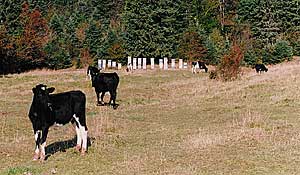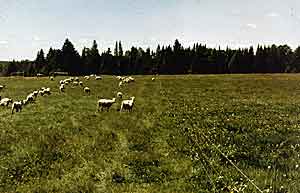Grazing Management in Humid Temperate Regions
In the 1950s, Andre Voisin of France developed the concept of intensive rotational grazing (IRG). In this system, livestock are turned into a new pasture or "paddock" at high stocking rates, and graze intensively for 1-3 days (the shorter the duration the better). They consume everything, but are not given time to overgraze and damage the crowns. Then they are moved to a new paddock and repeat the process. The paddocks are regrazed just when the rate of growth of the vegetation starts to level off, typically about 3 weeks after the previous grazing; the interval is longer in droughty weather. At this stage, most species are highly palatable, so there is little discrimination and all vegetation is consumed. Another benefit is a much more even distribution of manure and urine. IRG can increase the productivity per unit of land area up to several fold over the traditional systems. If nitrogen fertilizer is not used, it also stimulates legumes - notably white clover which is a good forage - and in turn eliminates need for nitogen fertilizer. The system works well in humid temperate regions but it has not as yet proven very successful in the humid and seasonal tropics.
IRG requires a higher level of management than the traditional system, and is only practical when you have movable electric fencing. Provision must be made to allow access to water in or from each paddock. From a landscape/biodiversity perspective, a downside is loss of biodiversity compared to the traditional systems. (Can you think of why biodiversity would be greater in the traditional system?).
Both systems are common in the Maritime provinces.
Somewhat different principles operate in semi-arid rangelands, and whether rotational type systems are appropriate is controversial.


Continuous grazing: note the close grazing of the more palatable vegetation and that other vegetation is untouched.


Intensive Rotational Grazing. Holstein cows in fenced paddock (above); strip grazing of sheep (below) - the electric fence enclosure is advanced progressively across the field; in the ungrazed paddock at right, an abundance of white clover is evident.